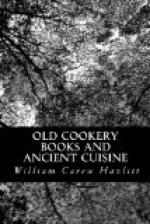The Liber, or rather Codex, Princeps in the very long and extensive catalogue of works on English Cookery, is a vellum roll called the Form of Cury, and is supposed to have been written about the beginning of the fifteenth century by the master-cook of Richard II who reigned from 1377 to 1399, and spent the public money in eating and drinking, instead of wasting it, as his grandfather had done, in foreign wars. This singular relic was once in the Harleian collection, but did not pass with the rest of the MSS. to the British Museum; it is now however, Additional MS. 5016, having been presented to the Library by Mr. Gustavus Brander. It was edited by Dr. Pegge in 1780, and included by Warner in his “Antiquitates Culinariae,” 1791. The Roll comprises 196 receipts, and commences with a sort of preamble and a Table of Contents. In the former it is worth noting that the enterprise was undertaken “by the assent and avisement of masters of physic and of philosophy, that dwelled in his (Richard II.’s) court,” which illustrates the ancient alliance between medicine and cookery, which has not till lately been dissolved. The directions were to enable a man “to make common pottages and common meats for the household, as they should be made, craftily and wholesomely;” so that this body of cookery was not prepared exclusively for the use of the royal kitchen, but for those who had not the taste or wish for what are termed, in contra-distinction, in the next sentence, “curious pottages, and meats, and subtleties.” It is to be conjectured that copies of such a MS. were multiplied, and from time to time reproduced with suitable changes; but with the exception of two different, though nearly coeval, collections, embracing 31 and 162 receipts or nyms, and also successively printed by Pegge and Warner, there is no apparent trace of any systematic compilation of this nature at so remote a date.
The “Form of Cury” was in the 28 Eliz., in the possession of the Stafford family, and was in that year presented to the Queen by Edward, Lord Stafford, as is to be gathered from a Latin memorandum at the end, in his lordship’s hand, preserved by Pegge and Warner in their editions. The fellowship between the arts of healing and cooking is brought to our recollection by a leonine verse at the end of one of the shorter separate collections above described:—




